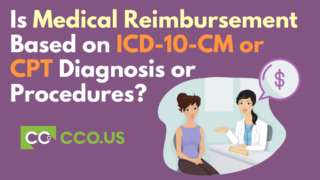This is a question that recently came in: Reimbursement, is it based on ICD-10-CM or CPT diagnosis or procedures?

The example I found was: How does the physician get paid for what they do? Well, physicians at this time are paid/reimbursed by what they do for the patient. These are called procedures and include the evaluation and management of the patient which is the exam and decision in treatment. Testing that is done is considered a procedure as well.
Let’s say we have a brand new physician:
Dr. X case 1: Mrs. S is a 68 y/o female on Medicare who presents to the clinic as a new patient with fever and sore throat. The physician performs a history and physical exam. The physician performed a rapid strep test, and he gives a diagnosis of viral pharyngitis. And then he recommends, in addition, that the patient takes Robitussin-DM.
So, here’s our brand new physician and he’s so excited to see his very first patient. Now, what did he provide? What services did he provide? Three main components for all visits to the physician:
1) Provider Visit – History/Physical/Medical Decision Making, the Physician performed the procedures.
2) Testing/Non-Physician Performed Procedures – Immunizations.
3) Office Work – nurses and the front desk/administrative services.
What services did the physician provide? Again, your doctor-patient encounter and all tests and procedures that are performed on the patient are considered “procedures.” Each “procedure” has a CPT Code, and for Mrs. S’ visit there’s a CPT Code for the Physician visit itself, and that’s considered an E/M code. Now, a CPT Code for the nurse’s work, that’s a little bit different. But, a CPT Code for the procedure, this rapid strep test, there’s a code for that.
This is based on an explanation to a physician as to how they would get paid.
Mrs. S’ Visit
- Physician Visit – CPT 99202
Let’s say it’s 99202.
- Nursing Work – CPT – (Office) – that didn’t get a code
- Rapid Strep – CPT 87880
- All Linked to ICD-10 Code J02 (Pharyngitis)
The doctor gets paid based on the CPT coding that is given, and the ICD-10-CM code supports the reason for the CPT codes. You can’t have one without the other, and that’s really the key.
At this time and this may change in the future, it is based on different instances such as home health and other things such as what was wrong with the patient, versus what is being done to the patient. And that’s how HCC coding is done too. It is coded by what is wrong with the patient. But at this time, your CPT code on what you did to the patient has to be supported by the diagnosis and then they can get paid. That’s why you have to do both. It goes back to those Relative Value Units that we were talking about.
If you go to the website that’s listed here, that is where I got this information. It goes into depth as it explains to a physician how he gets paid. It goes into detail about the Relative Value Units and much, much more. There was just so much information, I was shocked, and really actually quite excited. I bookmarked it because it’s going to make for great future scenario discussions and such. I liked the way the physician set that up. That website, of course, will be on the Replay Club so don’t panic. But it was really, really good; I was really impressed with it.
![[CCO] Certification Coaching Organization LLC [CCO] Certification Coaching Organization LLC](https://www.cco.us/wp-content/uploads/2015/05/CCO-Logo-2015-d3-500px.png)